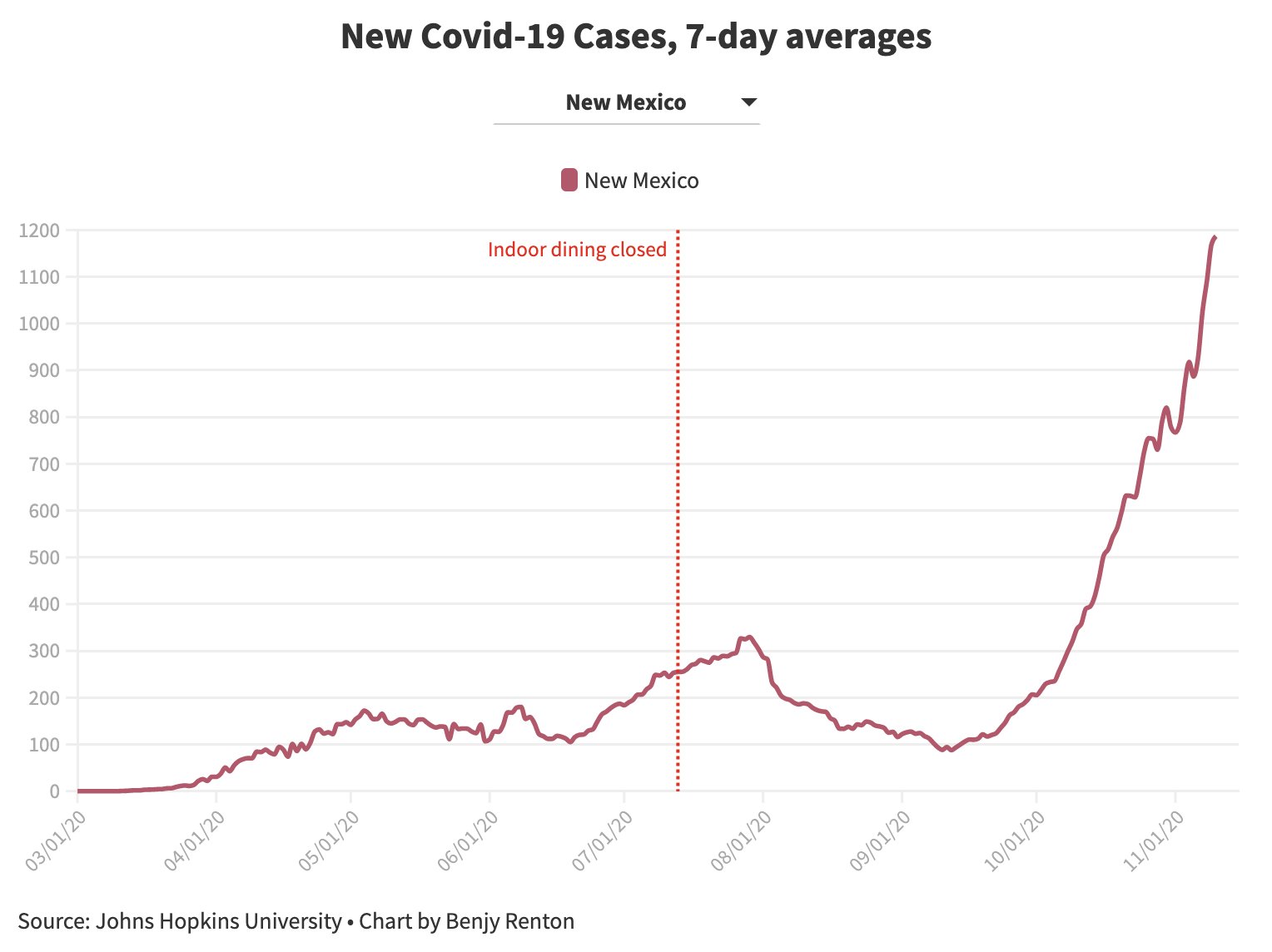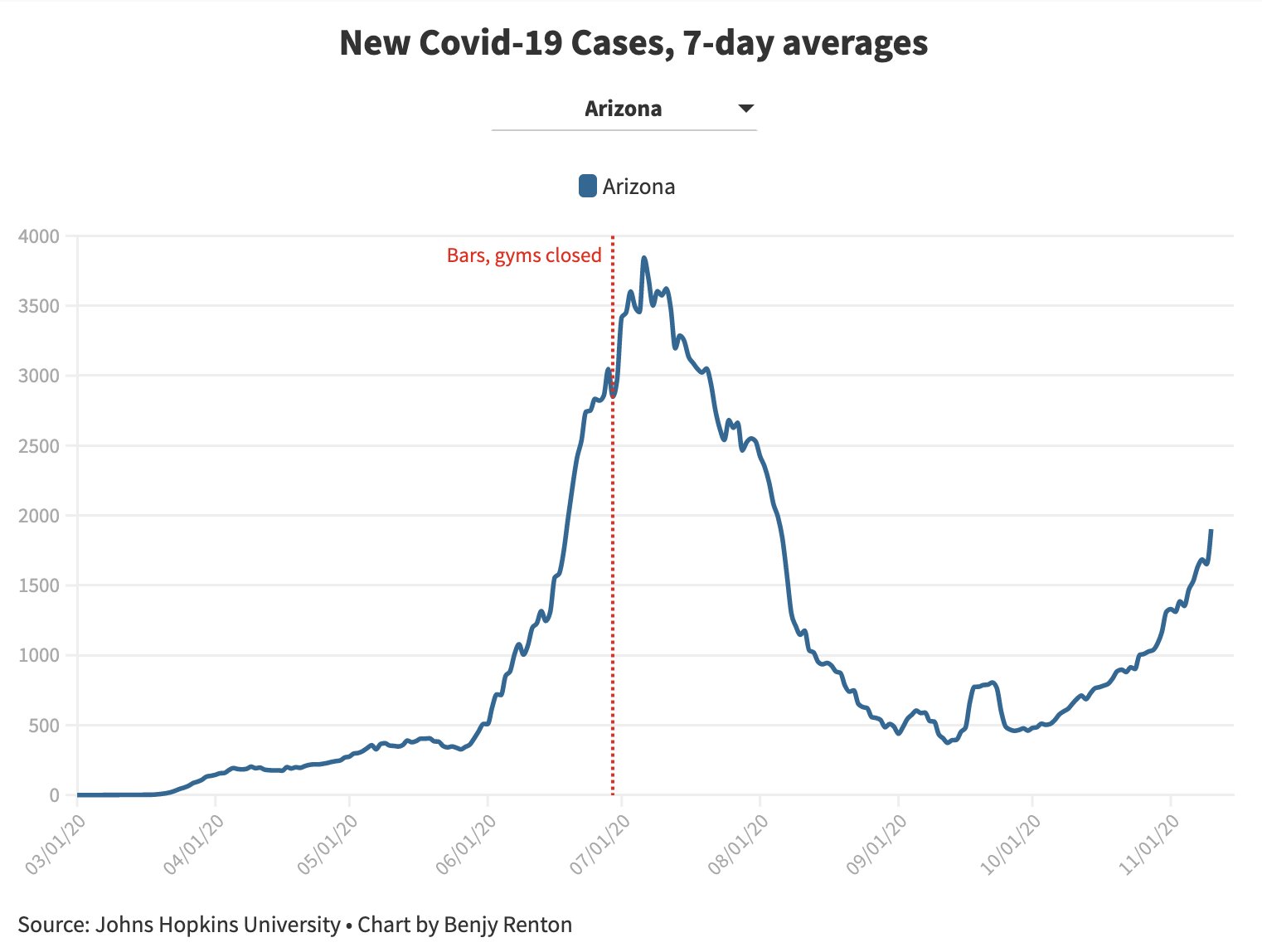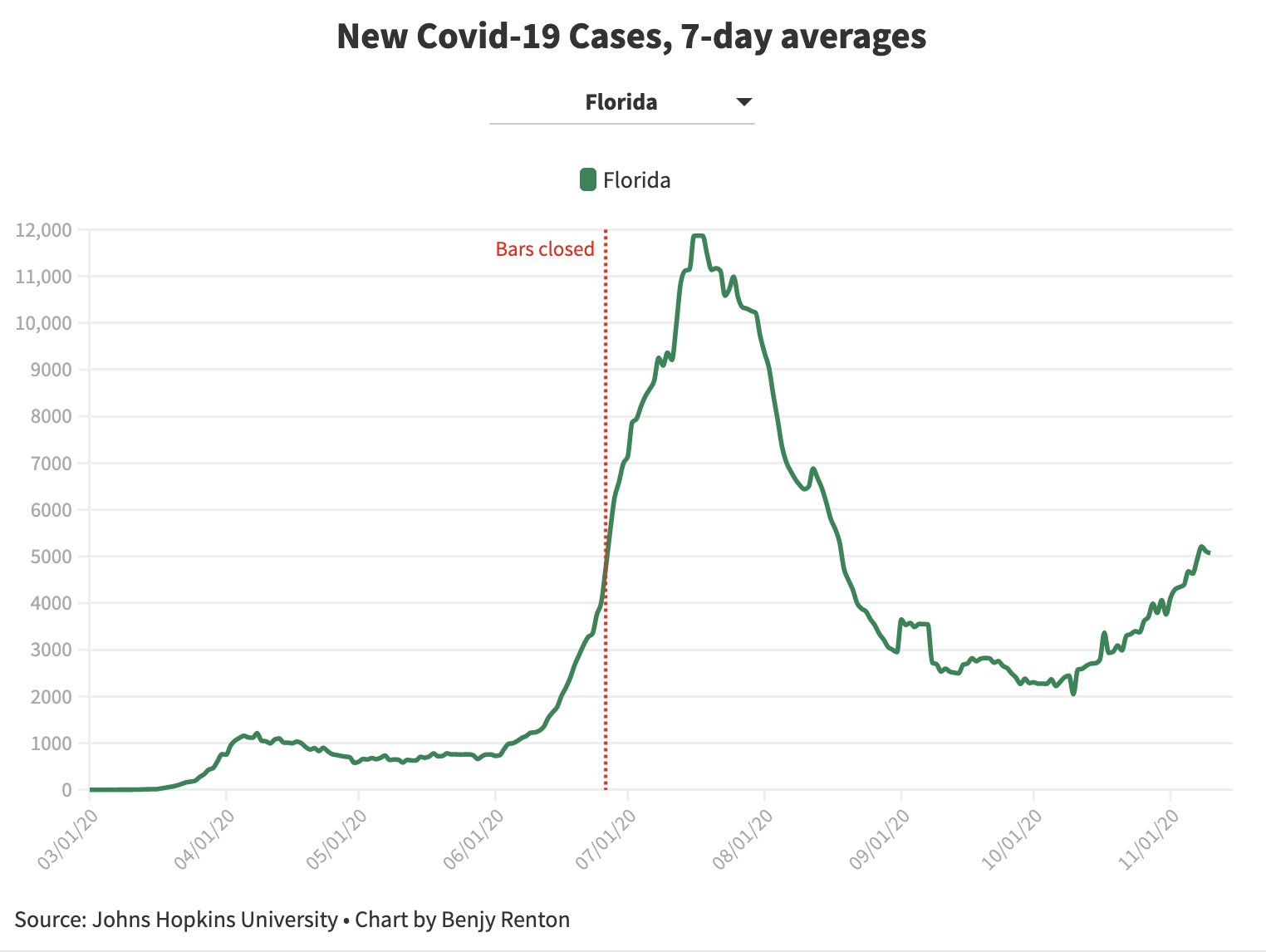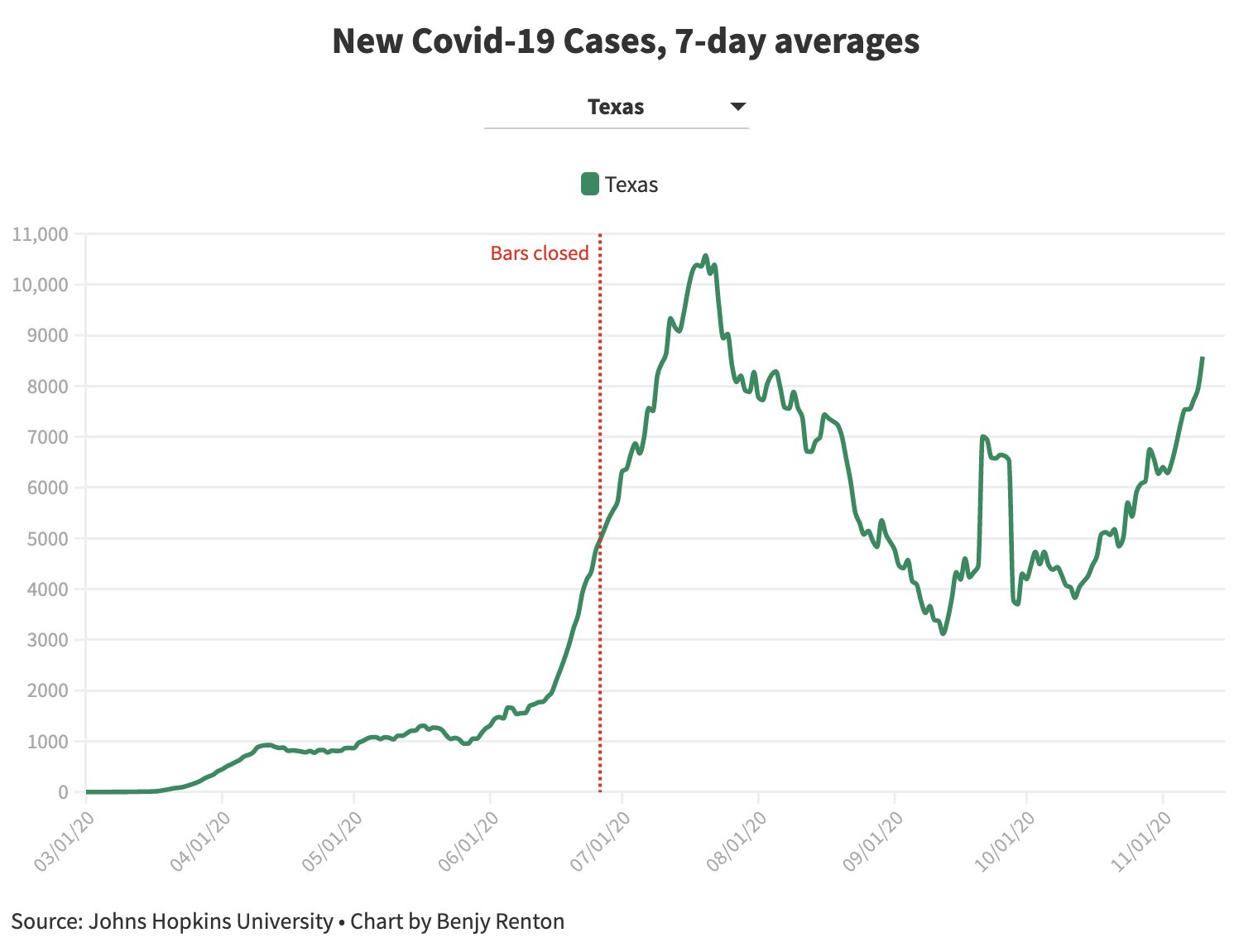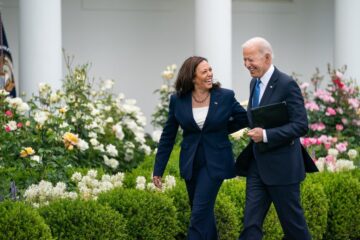Welcome back to Week 32 in my weekly reports analyzing the Covid-19 pandemic and its effects on the country and higher education. For those of you reading this on my blog, Off the Silk Road, I have also launched a newsletter, where these reports can be sent directly to your email each week. Click here to subscribe.
Last week, we took a closer look into surges throughout the nation and on college campuses. This week, we continue to see dire repercussions of a spike in cases before the Thanksgiving holiday and we will discuss why this holiday will determine our trajectory for months to come.
A national look
This week America paused to remember the 250,000 people we have lost to Covid-19. As the country sails past 12 million cases with no peak in sight, we must do all we can to slow the current devastating surge.
Over the past few weeks we have discussed catastrophic rises in cases. According to the COVID Tracking Project, on Friday, the U.S. recorded more than 192,000 cases in one day. It is only a matter of time until we pass the 200,000 mark. While Covid-19 cases are spiking, our attention certainly isn’t, according to an Axios analysis.
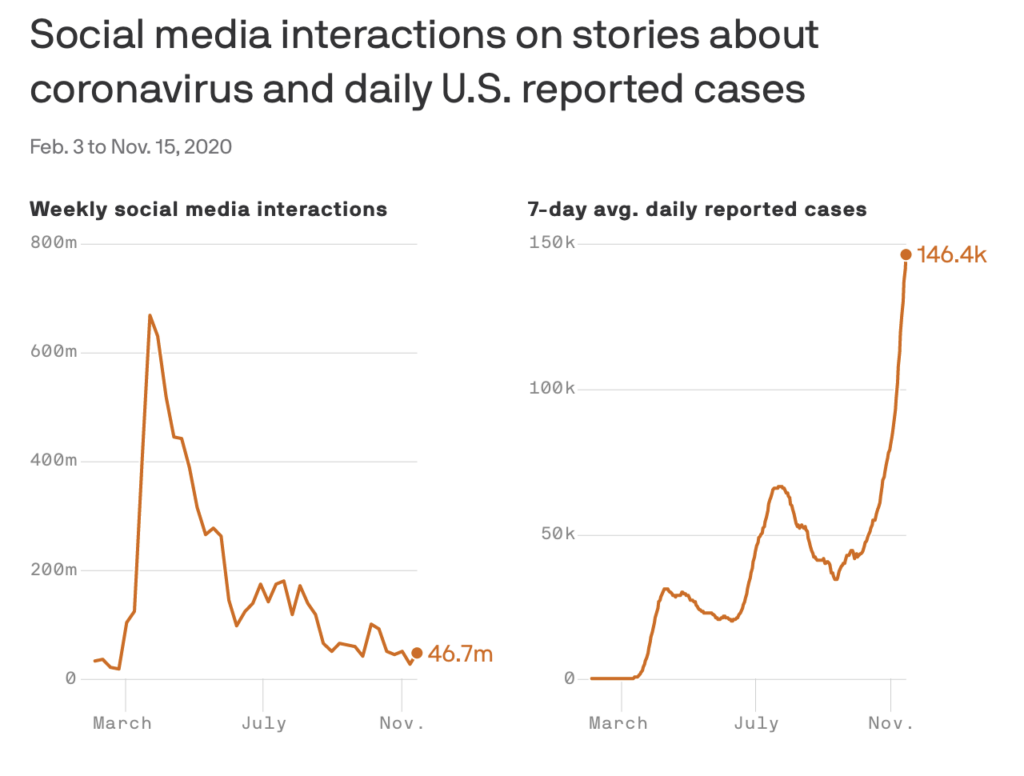
As we have seen throughout the past nine months, a rise in cases is followed by a rise in hospitalizations and deaths, both of which are lagging indicators. There are currently more than 83,000 Americans in the hospital, more than any other point since the pandemic began, and the 7-day average for deaths is over 1,400. Nearly a quarter of American hospitals do not have enough staff, and as states began to reimpose restrictions to save their healthcare systems, it will be a few more weeks of agony until we may see any effects. Many states have chosen to impose curfews on restaurants and bars, which make little epidemiological sense as the virus does not suddenly appear after 10 p.m. New York City schools have switched to remote learning on short notice, despite restaurants being open for indoor dining. “The virus has, with ruthless regularity, killed at least 1.5 percent of all Americans diagnosed with COVID-19 over the past four months,” Alexis Madrigal and Whet Moser write in The Atlantic. This means that of the 192,805 cases the U.S. recorded on Friday, it is possible that 2,892 of those will die. “Postponing travel and staying home is the best way to protect yourself and others this year,” the CDC says on Thanksgiving. “Celebrating virtually or with the people you live with is the safest choice this Thanksgiving.” It is clear that despite the pleas of public health experts, many Americans will still travel this Thanksgiving and hold gatherings with significant risk. More than 1 million people flew through U.S. domestic airports on Friday, the second-highest total since the pandemic hit. “After big Thanksgiving dinners, plan small Christmas funerals,” The Mississippi Free Press writes. Our nation’s public health systems are at a breaking point with this new round of infections, many in the Midwest where ICU capacity is already low.
With the national picture laid out for us, let’s take a look at what measures some states and localities are choosing to impose to counteract this surge. Michigan governor Gretchen Whitmer’s new guidelines are an excellent example of targeted restrictions that take high-risk areas for viral spread and curtail these activities, while keeping low-risk options open. Similar policies are being imposed in Philadelphia as well. Closing indoor dining, bars and gyms have been proven to work in other states, as seen from these graphs this past summer.
So I know what you’re thinking. These restrictions worked in the summer, but the fall surge is different. Let’s look at France, which enacted restrictions on October 30. Less stringent than their lockdown in the spring, restaurants, bars and cinemas are closed and movement outside the home is limited, but schools and parks are still open. Two weeks after restrictions were placed, we see a decline in cases. We need more information for a sustained decline, but these early results are promising. Deaths, a lagging indicator, are flatlining and could decline in coming weeks. We can do this too.
This all comes as a New York Times analysis finds that the surge is worse now in places where leaders neglected to keep up forceful virus containment efforts or failed to implement basic measures like mask mandates in the first place.
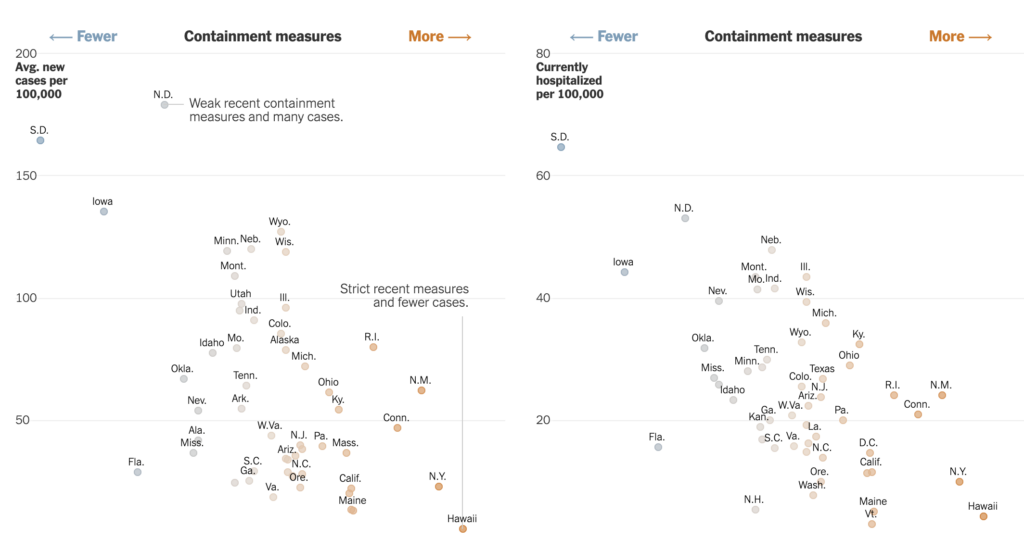
Let’s take a look at some of the latest scientific developments:
- How long might immunity to the coronavirus last? Years, maybe even decades, according to a new study reported in The New York Times — the most hopeful answer yet to a question that has shadowed plans for widespread vaccination.
- After July 3, Covid-19 incidence decreased in 24 counties with mask mandates but continued to increase in 81 counties without mask mandates, according to a CDC report.
- The FDA has authorized the first at-home coronavirus test, but it is expensive at $50 per test.
- A CDC report found that after the Sturgis, South Dakota motorcycle rally this summer, 51 confirmed primary event-associated cases, 21 secondary cases, and five tertiary cases were identified in Minnesota residents.
- We learn that mouthwash is unlikely to prevent you from contracting Covid-19, despite research showing that it is effective at killing viruses. While it may kill the virus in a lab, it is impossible to sanitize your mouth.
- A study from Denmark found that masks were ineffective, though the difference between the two groups was not statistically significant and the study itself had limitations.
- After identifying 3 cases of Covid-19 on October 11, the Chinese city of Qingdao tested 10.9 million people in 5 days and found 9 additional cases, according to The New England Journal of Medicine.
- After introduction of a testing strategy and other measures, a long-term facility in Pennsylvania had a 17-fold lower coronavirus disease case rate compared with those of neighboring facilities, according to the CDC.
- A new meta-analysis published in Nature calculated the rate of [truly] asymptomatic presentation to be 17%. Asymptomatic individuals were 42% less likely to transmit the virus than symptomatic people.
- A study published by the New Zealand government concluded that at least four in-flight events of SARS-CoV-2 transmission took place while on an 18-hour flight. While all passengers tested negative for Covid-19 before the flight, one passenger tested negative five days prior to travel and not immediately before the flight. This means it is entirely possible that the passenger contracted the virus before travel and due to inconsistent use in mask-wearing may have transmitted it on board.
- New data compiled by Brown University professor Emily Oster found that the case rate in New York City schools among elementary and middle school students is lower than the rate in the overall community, while the case rate among school staff and high school students is similar to the community rate.
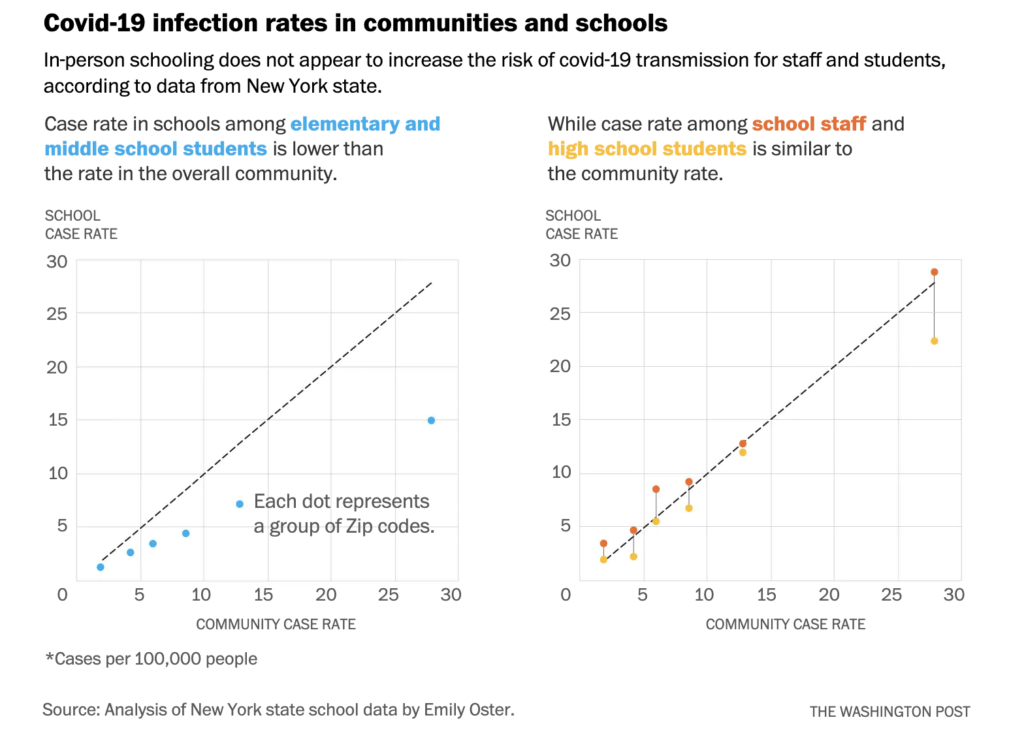
Finally, some exciting news on vaccines.
- Moderna released its results from its Phase III trial. They are encouraging — company data show 94.5% efficacy, including against severe illness. It is also stored at -4º F, compared to Pfizer’s -94ºF. The vaccine may be available in the 2nd half of December, with the trial expected to finish in 7-10 days.
- Pfizer said on Wednesday that its coronavirus vaccine was 95% effective and had no serious side effects and has since filed with the FDA for an emergency use authorization. The data showed that the vaccine prevented mild and severe forms of Covid-19, the company said, and it was 94% effective in older adults, who are more vulnerable to developing severe Covid-19 and do not respond strongly to some types of vaccines.
- SinoVac in China published results from its Phase I and Phase II trials. Comparatively modest antibodies were produced in participants, slightly lower than its U.S. competitors.
- A Kaiser Family Foundation analysis found that less than half of state vaccination plans contain an estimate for the number of people considered high priority to receive the vaccine.
- According to new modeling from Yale’s Dr. David Paltiel and Massachusetts General Hospital’s Dr. Rochelle Walensky, “we find that even highly effective vaccines–however defined–will struggle to produce large reductions in infections if implementation is slow, vaccine hesitancy is high, or there’s not a sustained commitment to other approaches that reduce the spread of the virus.”
“The scientific uncertainty at the heart of Covid-19 vaccines is resolved,” The Atlantic’s Sarah Zhang writes. “Vaccines work. And for that, we can breathe a collective sigh of relief.” With the first doses of vaccines possibly available in December, we know there is light at the end of the tunnel. The next national challenge is to keep Americans alive long enough to see that light. In the presence of a president who refuses to begin the transition of power (with a son who just tested positive), possibly jeopardizing vaccine distribution, and who golfs during a G20 Covid-19 summit, the American public must do all it can to keep our fellow citizens alive this winter. This includes minimizing gatherings this Thanksgiving, as we must assume that the virus is everywhere. Without mitigation, it will ravage through our families and cause even more pain this winter. Thanksgiving apart this year means a Thanksgiving together next year. Zoom is making it easy for families, lifting the 40-minute limit on free Zoom calls on Thanksgiving Day.
Let’s move on to our discussion of higher education.
Higher education
This week we remember 23-year-old Jamesha Waddell, a Livingston College student who has died from the coronavirus. Our condolences go out to her family and friends.
Each Friday, I update the College Watchlist, which is currently tracking 144,318 total cases at 96 colleges across the country. At the top of my list of cases in the last 7 days are:
- Ohio State University – 648
- University of Iowa – 432
- University of Wisconsin – 428
- Brigham Young University – 322
- Iowa State University – 306
The surge in cases can be attributed to Halloween and an influx in exit testing before students return home for Thanksgiving. I am concerned about high infection rates on campuses, as students will spread the virus to their families over the holiday.
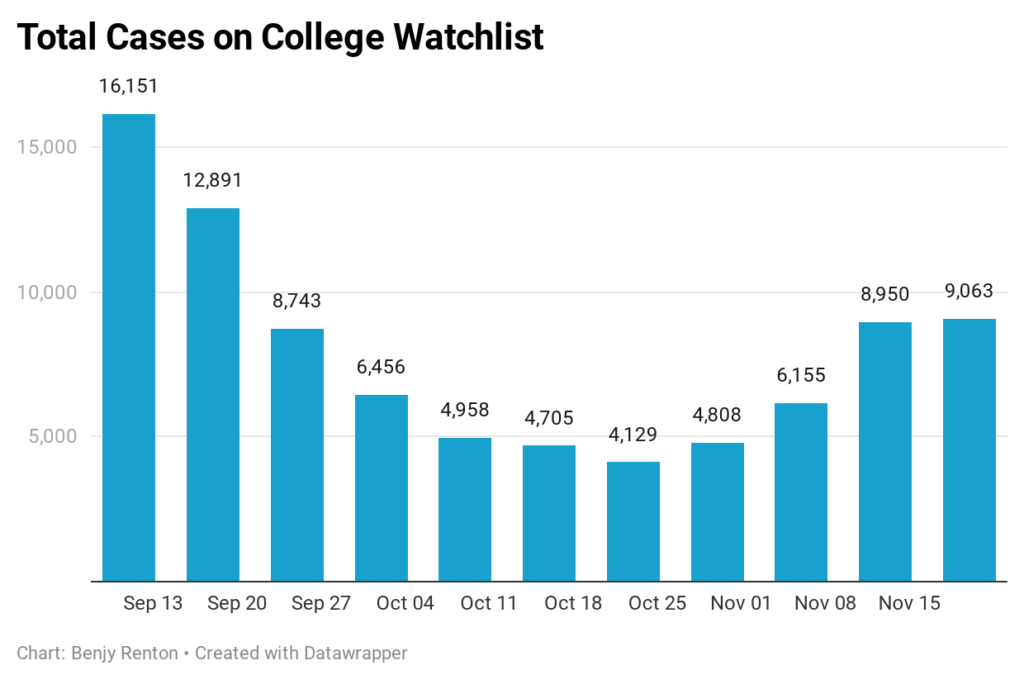
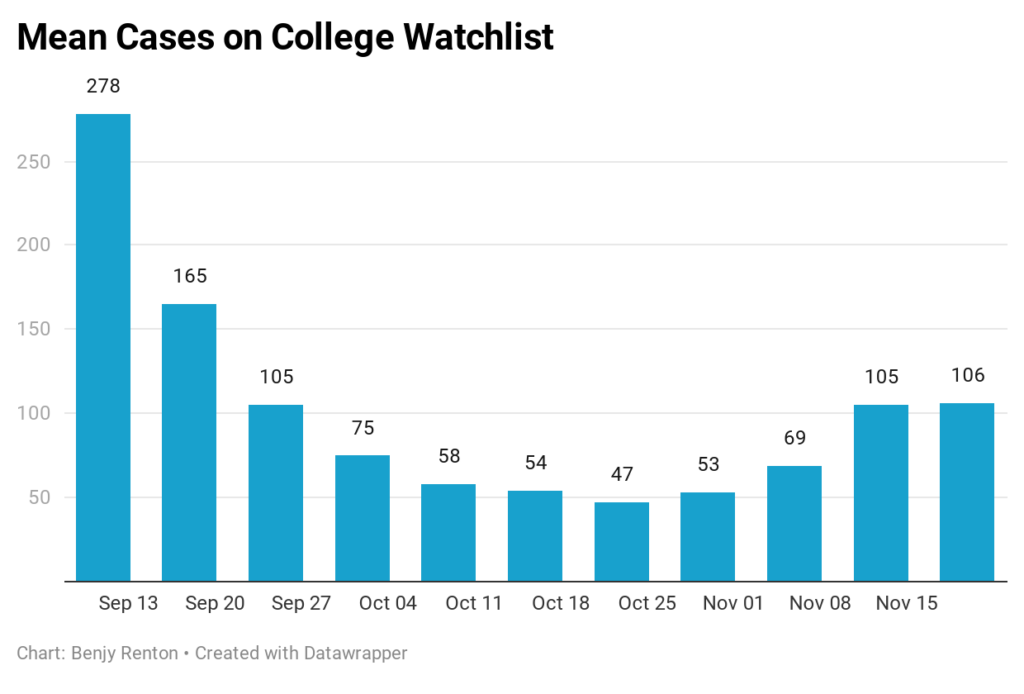
The New York Times is recording over 324,000 cases at its 1,700 schools and reported the highest two-week case increase since it started collecting data in October.
Here’s a roundup of this week’s higher ed news:
- The governors of several Northeast states are urging colleges to test students who live on campus for the coronavirus before they leave for Thanksgiving break.
- Columbia University has temporarily banned at least 70 students for violating the New York City school’s Covid-19 travel policy.
- Just days before students were set to travel around the country for Thanksgiving, the University of Washington had to cancel coronavirus tests for many students as the demand from community members with symptoms skyrocketed.
- The early days of the pandemic took a toll on faculty members with stress currently peaking, according to a new study of faculty mental health from Course Hero and reported in Inside Higher Ed.
- “Ultimately, next semester will be an exercise in trust-building for students, both with administration and with each other,” the editorial board at the University of Michigan writes. “Will the University prioritize students over profits to keep us safe?”
- Members of a sorority at the University of Alabama cancelled a 600-person party after a story was published in The Daily Beast on the possible superspreader event.
- “Be wise,” the editorial board at Michigan State University writes. “Reckless travel risks not getting to see your family next year.”
- The Massachusetts Daily Collegian’s Matt Berg analyzes Covid-19 cases at Massachusetts colleges and discusses cases and testing trends.
- A new CDC report shows how Duke’s comprehensive testing program (where on-campus undergrads were tested twice weekly), combined with contact tracing and other strategies resulted in 84 positive cases from August 2-October 11. 17 were detected on entry and 51% were asymptomatic.
- A new paper from researchers at UC Berkeley models various interventions (testing, tracing, symptom screening and cancelling large gatherings) in tandem to curb infections on college campuses. The paper shows that even testing regimes with slow (7+ day) turnaround times are useful when combined with contact tracing.
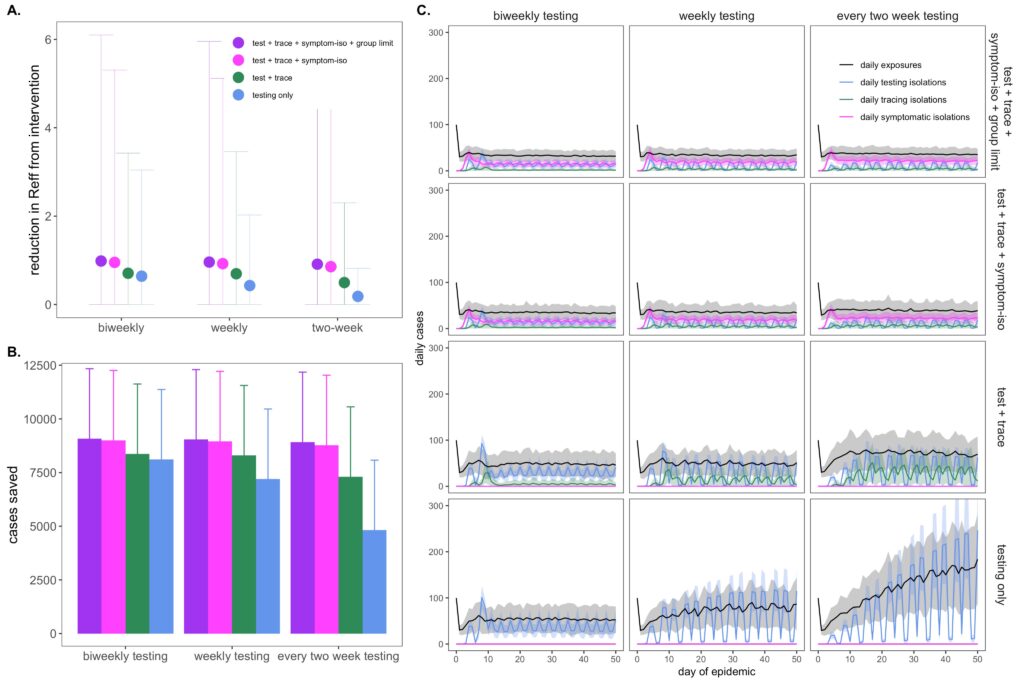
As we approach Thanksgiving and many colleges have provided little guidance for their students to depart safely, we will continue to monitor case counts. College students returning from campuses with high levels of infections should quarantine upon arriving home in order to avoid infecting family members.
The Good Stuff
Let’s roll the clips of the good stuff. In my usual tradition, I feature my favorite stories from the week. Here are my Top 10.
- Dolly Parton donated $1 million to fund research for a coronavirus vaccine.
- A New York Times photo essay shows how the U.S. Marines have used previous experiences with fighting infectious diseases to protect against the coronavirus.
- British Chongqing Consul General Stephen Ellison dove into a river in China last weekend to rescue a drowning student and swim her to safety.
- A frightened owl was rescued Monday after being found in the Rockefeller Center Christmas tree.
- Bloomberg published an in-depth feature of the hard work of the volunteers at the COVID Tracking Project.
- TikTok users have been busy this fall crowdsourcing music and set design for a new musical based on the Disney movie Ratatouille.
- Dr. Anthony Fauci supports local D.C. restaurants by regularly ordering takeout. Eater DC takes a look at his favorite spots.
- Esquire published an oral history into how CNN covered election week.
- The Broad Institute takes us on a tour into their Massachusetts lab, which processes Covid-19 tests for 108 colleges in New England and other nursing homes, hospitals and primary care facilities.
- The New York Times details their design process for their election week headlines.
Conclusion
“Not even the best-prepared hospital can compensate for an unchecked pandemic,” The Atlantic’s Ed Yong writes. “[The University of Nebraska Medical Center’s] preparations didn’t fail so much as the U.S. created a situation in which hospitals could not possibly succeed.”
With rising cases throughout the nation and deaths creeping up to spring levels, this Thanksgiving will determine our pandemic trajectory for months to come. At the current baseline we cannot sustain any more surges. Many hospitals are already at capacity and it will only get worse.
This Thanksgiving, stay home and tell your friends and family to do so as well. There is light at the end of the tunnel, but we must get through the tunnel first.
I’d like to thank all the student journalists with whom I have the pleasure of working. In the next weeks and months ahead, they will become vital in chronicling their colleges’ paths forward for the fall and beyond. Support their work by reading it.
My best to all for good health.
Like what you see? Don’t like what you see? Want to see more of something? Want to see less of something? Let me know in the comments. And don’t forget to subscribe to the weekly newsletter!
For more instant updates, follow me on Twitter @bhrenton.
